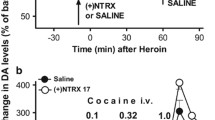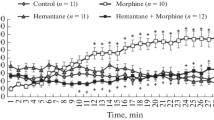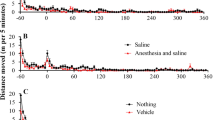Abstract
Dextro-naloxone [(+)-naloxone], an isomer with almost no opiate antagonist activity and no effect on spontaneous locomotor activity, can reduce cocaine-induced hyperactivity in mice. The classical opiate antagonist,levo-naloxone [(−)-naloxone], is known to counteract the excitatory motor effects of amphetamine and cocaine, but it has been tacitly assumed that this action oflevo-naloxone is dependent on its ability to antagonize endogenous opioids. Our finding that a naloxone isomer with little or no opioid antagonist activity is also able to inhibit the cocaine effect on spontaneous motility, calls for a reconsideration of this assumption.
Similar content being viewed by others
References
Alexander, G.J., and Chatterjie, N. 1991. Spontaneous motility in SW mice: amphetamine/naloxone antagonism. FASEB J. 5:A862.
Chatterjie, N., and Alexander, G.J. 1983. Naloxone-6-spiro-hydantoin: a new non-toxic compound with anticonvulsive properties. Neuropharmacol. 22:1151–1153.
Chatterjie, N., Laorden, M.L., Puig, M.M., and Alexander, G.J. 1989. Prevention of hyperthermia-induced seizures in immature rats by a hydantoin derivative of naloxone. Life Sci. 45:857–862.
Hooks, M.S., Jones, D.N., Justice, J.B., and Holtzman, S.G. 1992. Naloxone reduces amphetamine-induced stimulation of locomotor activity and in vivo dopamine release in the striatum and nucleus accumbens. Pharmacol. Biochem. Behav. 41:449–453.
Jones, D.N., and Holtzman, S.G. 1992. Effects of naloxone infusion upon spontaneous and apetamine-induced activity. Eur. J. Pharmacol. 221:161–165.
Jones, D.N., and Holtzman, S.G. 1994. Influence of naloxone upon motor activity induced by psychomotor stimulant drugs. Psychopharmacol. 114:215–225.
Chatterjie, N., Alexander, G.J., Sechzer, J.A., and Lieberman K.W. 1995. Amphetamine/naloxone interaction: Prolonged protection by naloxyl-6α-spirohydantoin. FASEB J. 9:A1372.
Iijima, I., Minamikawa, J., Jacobson, A.E., Brossi, A., and Rice, K.C. 1978. Studies in the (+)-morphinan series. 5. Synthesis and biological properties of (+)-naloxone. J. Med. Chem. 21:398–400.
Alexander, G.J., and Chatterjie, N. 1991. (+)-Naloxone antagonizes amphetamine-induced increase in spontaneous motility. FASEB J. 5:A682.
Chatterjie, N., and Alexander, G.J. 1992. Non-opiate effects of naloxone: antagonism of amphetamine-enhanced spontaneous activity in SW mice. FASEB J. 6:A994.
Scalzo, F.M., Ali, S.F., Frambes, N.A., and Spear, L.P. 1990. Weanling rats exposed prenatally to cocaine exhibit an increase in striatal D2 dopamine binding associated with an increase in ligand affinity. Pharmacol. Biochem. Behav. 37:371–373.
Houdi, A.A., Bardo, M.T., and van Loon, G.R. 1989. Opioid mediation of cocaine-induced hyperactivity and reinforcement. Brain Res. 497:195–198.
Kosten, T.A., Kleber, H.D., and Morgan, C. 1989. Role of opioid antagonists in treating intravenous cocaine abusers. Life Sci. 44: 887–892.
Kosten, T.A. 1990. Cocaine attenuates severity of naloxone-precipitated opioid withdrawal. Life Sci. 47:1617–1623.
Ramsey, N.F., and van Ree, J.M. 1991. Intracerebroventricular naltrexone treatment attenuates acquisition of intravenous cocaine self-administration in rats. Pharmacol. Biochem. Behav. 40:807–810.
Bain, G., and Kornetsky, C. 1987. Naloxone attenuation of the effect of cocaine on rewarding brain stimulation. Life Sci. 40: 1119–1125.
Bilsky, E.J., Montegut, M.J., Delong, C.L., and Reid, L.D. 1992. Opioidergic modulation of cocaine conditioned place preference. Life Sci. 50:85–90.
Brasch, H. 1986. Influence of the optical isomers of (+)- and (−)-naloxone on beating frequency, contractile force and action potentials of guinea pig isolated cardiac preparation. Brit. J. Pharmacol. 88:733–740.
Sarne, T., Hochman, I., Eshed, M., and Oppenheimer, E. 1988. Anti-arrhythmic action of naloxone: direct effect on the rat heart. Life Sci. 43:859–864.
Cregler, L.L., and Mark, H. 1986. Special report: Medical complications of cocaine abuse. New Engl. J. Med. 303:1495–1500.
Author information
Authors and Affiliations
Rights and permissions
About this article
Cite this article
Chatterjie, N., Alexander, G.J., Sechzer, J.A. et al. Prevention of cocaine-induced hyperactivity by a naloxone isomer with no opiate antagonist activity. Neurochem Res 21, 691–693 (1996). https://doi.org/10.1007/BF02527726
Accepted:
Issue Date:
DOI: https://doi.org/10.1007/BF02527726




